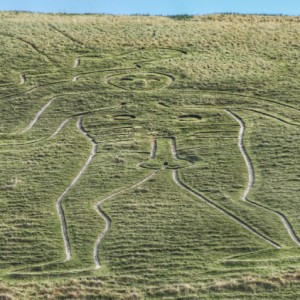Gold Hill, Shaftesbury
Thursday Oct 7
I have been wanting to visit this iconic English scene for a number of years now, having seen pictures of it on Blip and numerous other places - so today was the day! On the way to Shaftesbury, we stopped to explore the village of Cerne Abbas, including viewing the giant and looking inside the parish church, (see extra of giant, and top left two pictures of collage). The giant is probably one of England’s best known hillside figures, and is now in the hands of the National Trust. There has been long standing discussion about when it was originally built. The National Trust’s latest research suggests it was originally built in the Medieval period, but later forgotten about for generations, before being rediscovered and re-chalked at a later date. When we first arrived, the clouds were very low, and you could barely make out the outline, but fortunately, while we exploring the parish church and the rest of the village, the clouds lifted and there were glimpses of sunshine, so I was able to take a second shot, which revealed it more clearly. The parish church was notable for its paintings along the nave. Most of the cartouches date from about 1680. The wording of the texts comes from a number of different books of the bible.
Then it was on to Shaftesbury and Gold Hill. Gold Hill has been used as a setting for film and television. It appears in the 1967 film version of Thomas Hardy's Far from the Madding Crowd. However, in England it is probably best remembered as the main setting for the 1973 "Boy on Bike" television advertisement for Hovis bread. The ancient cobbled street runs beside buttressed walls of the precinct, which are the grounds surrounding ancient Shaftesbury Abbey, built by King Alfred the Great. The excavated foundations of the Abbey lie in a peaceful walled garden with traditional roses, a medieval orchard and an extensive herb garden where they cultivate many medicinal herbs that the nuns would have grown. We visited this next, and enjoyed an ice cream from their shop.
On our way back to Dorchester, we visited the quintessential picturesque village of Milton Abbas. ( see right three pictures and lower left of extra collage). The famous landscape gardener Capability Brown, worked on the design of Milton Abbas with renowned architect William Chambers. Together they created a visually stunning village that some consider one of the first planned settlements in England. In the 1770s, the owner of Milton Abbey House, Joseph Damer (1st Earl of Dorchester), felt the existing village of Middleton, with all its noises and smells was disturbing his rural idyll. So the new village of Milton Abbas was created with 36 almost identical cottages, each designed to house two families. Some of these cottages still house two families, whilst others have clearly been merged into one residence.
10,263 steps



Comments
Sign in or get an account to comment.


